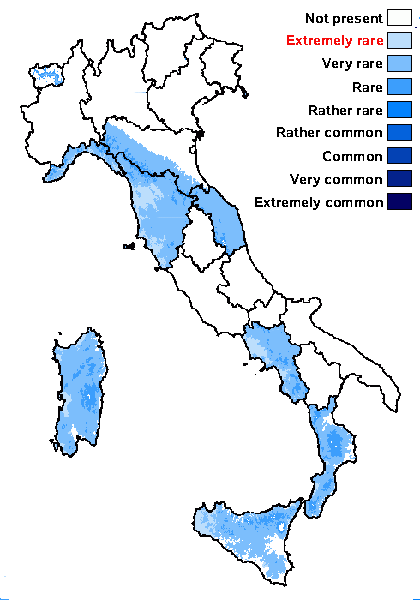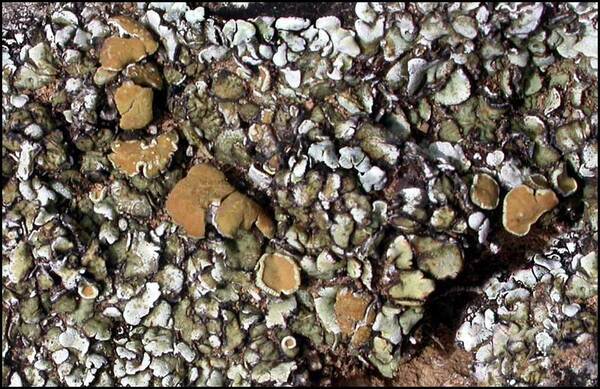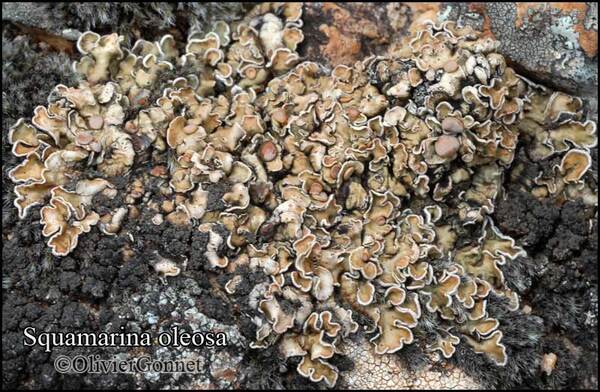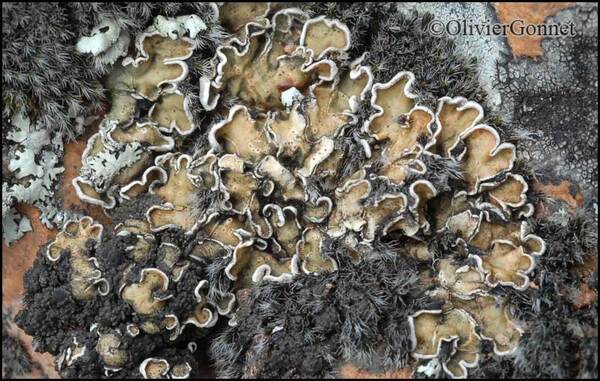Squamarina clauzadei Cl. Roux & Poumarat
Bull. Soc. linn. Provence, 75: 98., 2024
Synonyms: Squamarina oleosa auct. eur. non (Zahlbr.) Poelt
Distribution: N - VG, VA (Piervittori & Isocrono 1999), Emil (Tretiach & al. 2008, Fariselli & al. 2020), Lig. C - Tosc (Benesperi 2006, 2007b), Marc (Nimis & Tretiach 1999), Sar. S - Camp (Aprile & al. 2003), Cal (Puntillo 1996), Si (Ottonello & al. 1994).
Description: Thallus squamulose, 3-10 cm wide, 0.6-1(-1.5) mm thick, the squamules imbricate, bluish green when fresh, turning brownish in the herbarium, with an oily appearance, epruinose except in young stages, indistinctly lobed, the margins usually ascending, at first white then blackening, the lower surface dark grey to black, attached by concolour rhizinoid hyphal strands. Upper cortex 50-90 µm thick, with an epinecral layer which is hyaline and without crystals in the upper 10-30 μm, and inspersed with crystals in the lower 5-7 µm; true cortex 40-55 µm thick, densely plectenchymatous with isodiametrical cells in upper part and elongated cells in lower part; medulla white (brownish in lower part), up to 1.4 mm thick. Apothecia frequent, lecanorine, 1-4.4 mm across, finally constricted at base, with a yellowish white to pale brown, at first concave then flat disc and a thick, persistent, strongly pruinose, sometimes rugose or verrucose, finally rarely excluded thalline margin, the proper margin thin and poorly evident, level with disc. Thalline exciple 200-425 μm wide, corticate; proper exciple 100-170(-190) μm wide, filled with crystals, of anticlinally arranged hyphae; epithecium brownish, granular, 10-25 µm high; hymenium colourless, 60-80 µm high, hemiamyloid; paraphyses coherent, mostly simple, c. 1 μm thick at mid-level, the apical cells 2-3 μm wide; hypothecium colourless, 50-130 μm high, prosoplectenchymatous, with large crystals soluble in K and insoluble in N, I- (the subhymenium is thin and devoid of crystals). Asci 8-spored, elongate-clavate, with a thin, outer amyloid layer and a thickened, amyloid tholus devoid of an ocular chamber, penetrated by an axial tube the sides of which stain I+ deeper blue, approaching the Porpidia-type. Ascospores 1-celled, hyaline, long-ellipsoid to subfusiform, (11.5-)13-18(-20) x (2-)2.5-3.7(-4.3) µm in the nominal variety, (8-)10-14(-17) x (3-)4.5-5.5(-7) µm in var. microspora Cl. Roux & Poumarat, with more or less pointed ends. Photobiont chlorococcoid. Spot tests: thallus K-, C-, KC- or KC+ faintly yellow, P-; medulla P+ yellow. Chemistry: cortex with usnic and isousnic acids; medulla with psoromic and 2ʹ-O-demethylpsoromic acids. Note: a typically submediterranean lichen found in fissures of porous calcareous rocks; never common, but certainly more widespread. This lichen has been often called Squamarina oleosa (Zahlbr.) Poelt by European authors, but according to Roux & al. (2024) S. oleosa is a different species, from eastern Asia (China).
Growth form: Squamulose
Substrata: rocks
Photobiont: green algae other than Trentepohlia
Reproductive strategy: mainly sexual
Commonnes-rarity: (info)
Alpine belt: absent
Subalpine belt: absent
Oromediterranean belt: absent
Montane belt: rare
Submediterranean belt: very rare
Padanian area: absent
Humid submediterranean belt: very rare
Humid mediterranean belt: extremely rare
Dry mediterranean belt: absent

Predictive model
Herbarium samples

Courtesy Danièle et Olivier Gonnet - Source: https://www.afl-lichenologie.fr/Photos_AFL/Photos_AFL_S/Squamarina_oleosa.htm
France, fissures de rochers calcaires - session AFL 2008 - Lozère

Courtesy Danièle et Olivier Gonnet - Source: https://www.afl-lichenologie.fr/Photos_AFL/Photos_AFL_S/Squamarina_oleosa.htm
France, fissures de rochers calcaires - session AFL 2008 - Lozère

Courtesy Danièle et Olivier Gonnet - Source: https://www.afl-lichenologie.fr/Photos_AFL/Photos_AFL_S/Squamarina_oleosa.htm
France, 4/5/2011 - Parc Tre Padule - Corse de rochers calcaires - session AFL 2008 - Lozère
Growth form: Squamulose
Substrata: rocks
Photobiont: green algae other than Trentepohlia
Reproductive strategy: mainly sexual
Commonnes-rarity: (info)
Alpine belt: absent
Subalpine belt: absent
Oromediterranean belt: absent
Montane belt: rare
Submediterranean belt: very rare
Padanian area: absent
Humid submediterranean belt: very rare
Humid mediterranean belt: extremely rare
Dry mediterranean belt: absent

Predictive model
| Herbarium samples |

Courtesy Danièle et Olivier Gonnet - Source: https://www.afl-lichenologie.fr/Photos_AFL/Photos_AFL_S/Squamarina_oleosa.htm
France, fissures de rochers calcaires - session AFL 2008 - Lozère

Courtesy Danièle et Olivier Gonnet - Source: https://www.afl-lichenologie.fr/Photos_AFL/Photos_AFL_S/Squamarina_oleosa.htm
France, fissures de rochers calcaires - session AFL 2008 - Lozère




